Exploring the Artistic Representation of Waves
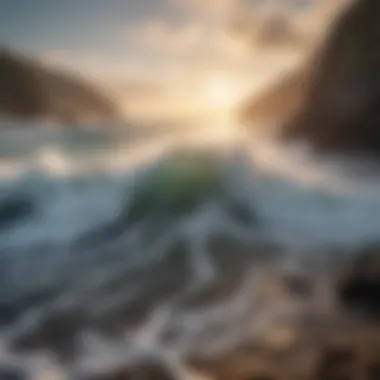
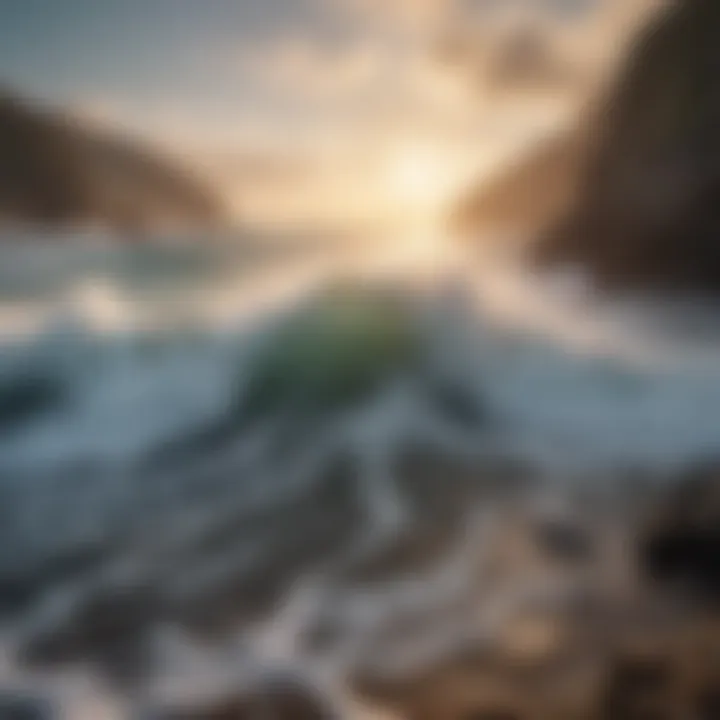
Intro
Waves have held a profound enchantment for artists across centuries. From delicate brushstrokes capturing the fleeting moments of sunlight glinting off water to vivid colors expressing the sheer power of the ocean, the portrayal of waves in painting serves as a testament to the relationship between nature and artistic expression. This exploration seeks to illuminate the numerous ways in which artists have interpreted water's restless dance.
Throughout history, waves symbolize much more than just a body of water; they embody movement, change, and a myriad of emotions. Whether depicted in the turbulent swells of a stormy sea or the serene ripples of a sunset reflection, waves provide a rich palette for creativity. Such imagery not only illustrates the natural world's beauty but also reflects our own internal tides of emotion.
As we plunge into the world of wave paintings, we unravel the techniques and skills—both fundamental and sophisticated—that underpin this art form. We will discover how artists have honed their craft, transforming the water's essence into captivating visuals. It will also be essential to explore the cultural significance of these paintings, revealing how different societies have perceived and revered the ocean and its waves.
In doing so, this narrative will offer insights that extend to those engaged in watersports and art lovers alike. By understanding this artistic portrayal of waves, we engage not only with the craft of painting but also with our collective human experience, shaped significantly by our interaction with water and nature.
Prologue to Wave Painting
In the realm of art, the depiction of waves serves as a conduit between the viewer and the enchanting world of water. This section shines a spotlight on the intricate relationship between water and painting, through which artists have historically endeavored to capture the essence of the ever-changing tides. Understanding wave painting is not merely about recognizing brush strokes on canvas; it's about appreciating the deeper emotional and cultural significance embedded in these representations.
Definition and Significance
Wave painting refers to the artistic portrayal of oceanic movements, capturing the dynamic nature of waves through various styles and techniques. This form of art symbolizes a myriad of human emotions, from the alluring freedom experienced during a peaceful sail to the raw power associated with a tempestuous sea.
By delving into the world of wave painting, one may notice its significance transcending far beyond mere aesthetics. Waves often represent the transient state of existence, embodying the notion that life is continuously shifting and evolving. Artists utilize this metaphor to evoke reflection upon personal experiences and societal issues, providing viewers with an opportunity to engage in a deeper dialogue about their own relationship with nature.
In a world inundated with the hustle and bustle of modern life, these paintings can act as a breath of fresh air—inviting individuals to pause, reflect, and connect with the beauty and power of the ocean.
Historical Context of Water in Art
Water has been a subject of fascination among artists for centuries, appearing in myriad forms across various cultures and epochs. From the rippling brooks in ancient paintings to the mighty oceans captured during the Romantic era, the portrayal of water reflects not only the artist's intent but also the outlook of society at the time.
In earliest civilizations, water was revered as a fundamental life source, symbolizing purity and renewal. For instance, in ancient Chinese art, water was associated with balance and harmony, reflecting the philosophical ideals of Taoism. The aesthetic of water in these paintings served as a representation of the natural world's interconnectedness.
Fast forward to the Impressionists, who focused on the fleeting effects of sunlight on water surfaces. Artists such as Claude Monet managed to depict the elusive beauty of water through dappled light and shifting colors, inviting viewers to appreciate the imperfections of nature.
Through centuries, the representation of waves has also served to signal humanity’s exploration and confrontation with the unpredictability of the ocean. Each brushstroke tells a story, reflecting not just the physical characteristics of water but also its metaphorical significances in human life.
For those engaged in water sports and adventure, wave paintings resonate on a personal level. They invoke feelings of nostalgia and excitement, capturing not just the visual splendor of waves, but also the thrill and challenge posed by the sea itself.
"Art is not freedom from discipline, but disciplined freedom." - John F. Kennedy
In summary, as we traverse the oceans of creativity through wave paintings, we uncover a world that intertwines natural beauty with profound emotions. Such an exploration reveals the power of art to not only depict the world around us but to shape our understanding of ourselves in relation to that world.
Cultural Representations of Waves
Within the realm of art, waves emerge not merely as a backdrop but as powerful symbols and integral elements that resonate deeply across various cultures. The way waves are portrayed and interpreted is significant, informing us about the historical, emotional, and spiritual connections people have with water. When we explore cultural representations of waves, we uncover layers of meaning that enhance our understanding of both art and the human condition. Artists from different backgrounds harness wave imagery not just for aesthetic pleasure but to convey messages about life's turbulence, renewal, and the ever-changing nature of existence.
Waves in Various Cultures
Across the globe, waves figure prominently in the visual narratives of diverse cultures. From the white-capped crests of the Pacific Ocean, as depicted in indigenous artwork, to the serene waters of the Mediterranean seen in classical paintings, waves serve as a canvas for cultural expression.
- Japanese Culture: The famous ukiyo-e prints, such as Hokusai's The Great Wave off Kanagawa, exemplify how waves are imbued with both beauty and chaos. For the Japanese, waves often represent the power of nature and the artist's struggle against it. This duality reflects a cultural reverence for the ocean as a source of both sustenance and destruction.
- Indigenous Art: Many Indigenous cultures use wave motifs to symbolize community and connection to the land. For instance, some Native American tribes incorporate wave patterns into their pottery and textiles, signifying both the life-giving properties of water and its role in a sacred narrative.
- Western Art: European artists, particularly during the Romantic period, portrayed waves to evoke emotion. Artists like J.M.W. Turner painted tumultuous seas, using them to elicit feelings of awe and fear, capturing nature's wildness as a reflection of human emotion.
Symbolism of Waves in Art
Waves carry profound symbolism that transcends geographical boundaries. In various artistic expressions, they represent both external and internal conflicts. Here are some underlying meanings associated with wave imagery:
- Transition and Change: Waves are synonymous with transition, reflecting life's inherent volatility. They can symbolize the cycles of life, depicting the inevitability of change, just as the tide ebbs and flows.
- Freedom and Adventure: For many, waves embody the spirit of exploration and freedom, inspiring adventure-seekers and enthusiasts of watersports to chase their passions. Artists often capture the exhilaration felt when surfboards slice through waves, connecting physical pursuits with the beauty of nature.
- Emotional Depth: Waves can metaphorically represent the depths of human emotions, reflecting turbulence, inner conflict, or tranquility. A calm, lapping wave might signify peace, while crashing waves can evoke feelings of turmoil or struggle.
"Waves are more than mere water; they symbolize the essence of human experience, encompassing everything from chaos to serenity."
In summary, cultural representations of waves in art provide a rich tapestry that informs our understanding of diverse beliefs and human experiences. By analyzing these themes, we not only appreciate the artistic techniques employed but also the deeper meanings woven into the fabric of each piece, encouraging us to reflect on our relationship with water and creativity.
Techniques in Painting Waves
The depiction of waves in art goes beyond mere representation; it captures the essence of movement, energy, and emotion. The techniques employed in painting waves are instrumental in conveying these elements. An understanding of such techniques provides insight into how artists interpret the dynamic and often unpredictable nature of water. Each brushstroke, color choice, and play of light contributes to the final composition, crafting an engaging narrative that resonates with viewers.
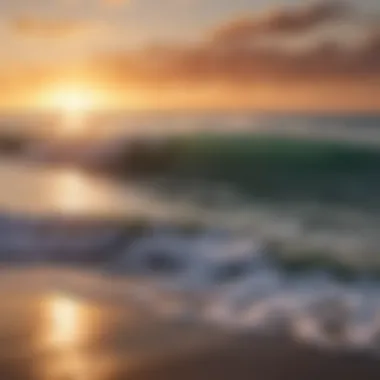
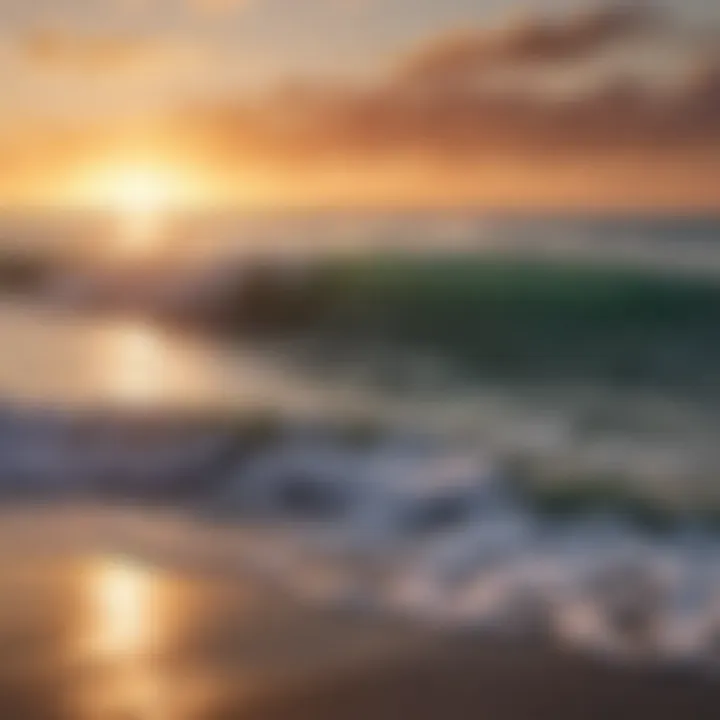
Brushwork and Texture
Brushwork is fundamental in creating the illusion of fluidity and motion in wave paintings. Artists often employ varied strokes to emulate the intricate textures of water. For instance, a stippling technique may be applied to portray the frothy whitecaps, while sweeping motions can depict the gentle curves of the swell. The depth of texture not only gives realism but also enhances the overall visual experience.
Textures can evoke different sensations; a coarse texture can represent the tumultuous ocean, whereas smooth strokes might embody calm seas. The application of oil paints allows for layering, enabling artists to build depth and complexity in their artworks, which enables observers to almost feel the water's movement.
"The brush is an artist's voice, speaking through textures that tell the ocean's stories."
Color Palette Selection
Selecting the color palette is crucial, as colors greatly influence perception and mood in wave paintings. Artists typically opt for a combination of blues, whites, and greens to depict various aspects of water. However, the choice of shades can diverge significantly based on the atmosphere the artist aims to create. Lighter hues simulate a sunny day where the waves glisten, while darker tones can suggest depth or a stormy sea.
Mixing colors to create unique transitions allows for gradual shifts that reflect a natural appearance. For example, using a gradient from deep navy to azure can portray the movement from the ocean floor to the surface. Additionally, the use of complementary colors may intensify the vibrancy of the artwork, drawing the eye and amplifying the emotional impact of the wave imagery.
Incorporating Light and Reflection
Light plays a pivotal role in the representation of waves, encapsulating the duality of water as both a reflective surface and a dynamic force. The strategic placement of highlights and shadows creates a sense of realism and depth. Artists often tackle the challenge of rendering the shimmering effect of sunlight on water's surface. Incorporating reflections, they can convey the wave's interaction with its surrounding environment, adding layers to the visual narrative.
Understanding light's behavior on water is essential. For instance, an artist might employ a glazing technique to layer transparent colors, mimicking the subtle changes in lighting as it dances across the water. These reflective elements not only enhance aesthetic appeal but also contribute to the overall meaning of the artwork. Art that captures the interplay of light and waves can provoke thoughts on time, tranquility, and the ceaseless flow of nature.
In summary, mastering the techniques of brushwork, color selection, and the representation of light and reflection can enable artists to create compelling wave paintings that resonate emotionally with viewers. These aspects not only refine the visual impact but also ensure that the essence of water is translated into artwork that captivates and inspires.
Notable Artists and Their Masterpieces
The world of wave painting has been significantly shaped by a number of notable artists whose works have left an indelible mark on the art community and beyond. These artists are not just painters; they are cultural commentators who use the metaphor of waves to reflect human emotions, environmental realities, and timeless traditions. Understanding their masterpieces sheds light not only on the artistic techniques but also on the underlying philosophies that drive their work. Indeed, through their interpretations of water in motion, they invite viewers to engage with a complex tapestry of emotions and reflections that often mirror our own experiences.
Hokusai and The Great Wave
Katsushika Hokusai’s work, particularly The Great Wave off Kanagawa, is a prime example of how wave imagery can transcend mere representation. Painted in the early 1830s, this piece encapsulates the raw power of nature, where towering waves threaten small boats that seem almost lost in the vastness of the sea.
This artwork isn’t just visually striking; it serves multiple symbolic purposes: a testament to the might of nature, a commentary on human vulnerability, and a reflection of Japan's cultural identity during a time of change. Hokusai's intricate details in the wave formation showcase his mastery of woodblock printing techniques.
- The contrast between the deep blue of the wave and the white foam captures a moment that feels both exhilarating and terrifying.
- Moreover, this artwork has influenced countless artists and pop culture, securing its status as a hallmark of wave art that evokes strong emotional responses.
Turner’s Captivating Seascapes
J.M.W. Turner, often lauded as the painter of light, made waves his muse, channeling their beauty and chaos into breathtaking seascapes. His painting The Fighting Temeraire stands as a pivotal work where the waves symbolize change and the passage of time. The ship, representing the old naval glory, is contrasted against the turbulent waters of a sunset, suggesting the end of an era.
Turner's brushwork is adept at capturing the essence of movement in water. Notably,
- His use of color vibrancy communicates not only the physical characteristics of waves but also the emotional undercurrents of the scenes.
- The ethereal quality of his works invites viewers into a wider contemplation of nature’s duality; serene one moment, ferocious the next.
His works push beyond the literal and into the realm of the poetic, establishing a dialogue between landscape and human experience that continues to resonate.
Contemporary Artists Exploring Water
In recent years, contemporary artists have also made significant strides in wave painting, though their approaches vary markedly from their predecessors. Artists such as Alexis Rockman and Damien Hirst explore not just the aesthetic but the ecological implications of water.
- Alexis Rockman, with his vivid depictions of oceanic landscapes, often incorporates allegorical references to climate change and biodiversity loss, using waves as a medium for environmental discourse.
- Damien Hirst’s works may, at first glance, appear provocative, yet they encourage viewers to ponder the interactions between humanity and the aquatic realm.
These artists infuse modern themes into their portrayal of waves, creating a fusion of beauty and commentary that challenges viewers to think critically about the future of our oceans. By embracing both traditional techniques and innovative concepts, contemporary wave artists enrich the ongoing exploration of the delicate relationship between art and nature.
"Art is the most beautiful of all lies."
– Pablo Picasso
Through examining these notable artists and their masterpieces, readers are invited to recognize the profound connections between human emotion, environmental issues, and artistic expression embodied in the ever-changing waves.
Technological Influences on Wave Painting
The rapid advancement in technology has undoubtedly reshaped the artistic landscape, particularly in the realm of wave painting. Technology not only provides artists with tools to enhance their creativity but also offers new avenues for expression that were unthinkable just a few decades ago. In this section, we’ll explore the significance of technological influences on wave paintings, delving into specific innovations like digital art and 3D modeling.
Digital Art Innovations
Digital art has revolutionized the way artists conceptualize and create wave imagery. Utilizing software like Adobe Photoshop or Corel Painter, painters can mimic traditional techniques while enjoying the ability to manipulate colors and textures with unprecedented precision.
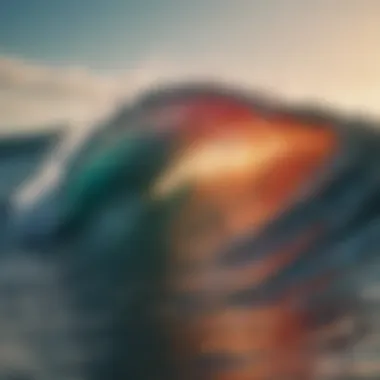
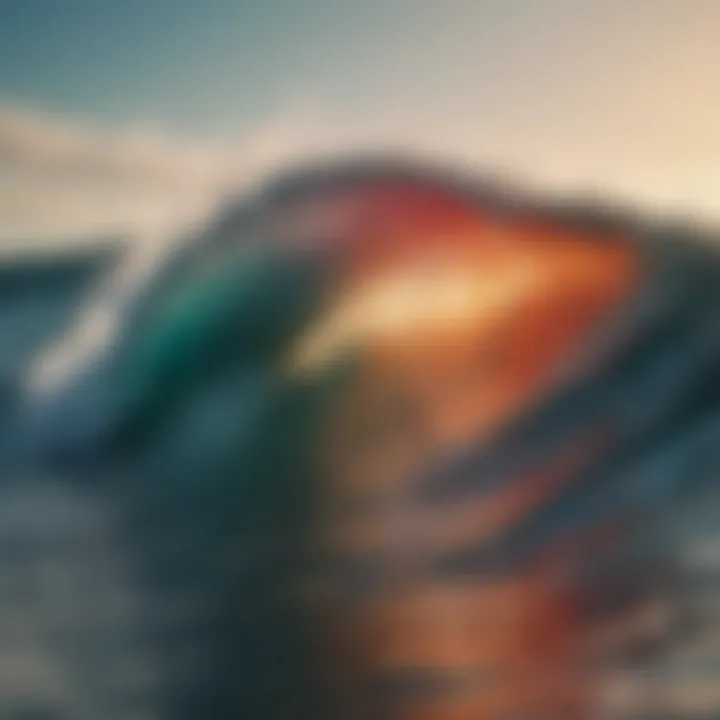
For example, an artist may create a realistic depiction of a stormy sea, experimenting with the brush tools to replicate the chaotic motion of the tidal waves. This method allows for the adjustment of details in real-time, which can lead to a level of refinement that physical mediums may struggle to achieve. Additionally, digital platforms facilitate easy sharing and feedback, connecting artists with audiences around the globe. This interactivity enhances the visibility of wave paintings and increases appreciation for the craft within an engaged community.
"The marriage of art and technology may produce stunning works that transcend traditional boundaries, allowing filmmakers, game designers, and illustrators to collaborate in creating immersive experiences centered around wave imagery."
3D Modeling of Water Dynamics
The progress made in 3D modeling is another crucial element impacting wave painting. Tools like Blender or Autodesk Maya allow artists to visualize water dynamics in three dimensions, illustrating the intricate behaviors of waves. Artists can simulate how waves interact with the shoreline or how light refracts through the water, enhancing their understanding of natural phenomena.
Through 3D modeling, artists can create animated visuals of waves, exploring how forms shift and change over time. This not only adds depth to their artistic portrayal but also allows for a more scientific approach to understanding marine environments. With detailed models, creators can also produce photorealistic images that can be incorporated into films, video games, or other visual mediums.
Furthermore, as the technology continues to improve, more artists are adopting these techniques to enhance their works. They can present dynamic artworks, where a still image evolves into a living scene, captivating viewers in a way that static traditional paintings cannot.
In summary, technological influences have opened up a new world of creativity for artists focusing on wave imagery. By incorporating digital tools and 3D modeling into their practice, they not only expand their own capabilities but also deepen the audience’s engagement with the art form.
Psychological Impact of Wave Imagery
The portrayal of waves in art opens a window into the psyche, showcasing the profound effects that water imagery can have on viewers. This section delves into the emotional and psychological responses elicited by depictions of waves, emphasizing how these elements can resonate deeply with audiences, fostering a connection between them and the natural world.
Emotional Responses to Water Art
Art featuring waves often evokes a myriad of emotions, ranging from serenity to exhilaration. This emotional spectrum can be attributed to several factors:
- Nostalgia: Many individuals associate waves with memories of vacations, childhood, and exploratory adventures at the beach. The vivid imagery of crashing surf can transport viewers back to those carefree moments.
- Calmness: The rhythmic motion of waves can induce a sense of peace and tranquility. Such artworks can serve as mental escapes from the rigors of daily life, creating a sanctuary of calm that many seek in times of stress.
- Exhilaration: On the flip side, images of tumultuous seas can evoke excitement, drawing in those who crave adventure. Adventure seekers resonate with the raw power of nature depicted in such artworks, feeling a rush of adrenaline at the thought of battling the waves.
This emotional duality highlights the unique role of wave imagery in art, wherein it serves not only as a subject of beauty but also as a catalyst for experiencing profound emotions.
Nature’s Influence on Mental Well-Being
The impact of wave imagery extends beyond just momentary emotions. Several studies affirm the therapeutic benefits of engaging with water-themed art:
- Stress Reduction: Exposure to nature, including water, has been shown to lower cortisol levels. Viewing wave paintings might offer a similar reduction in stress, as they bring the tranquility associated with nature into one’s living space or mental landscape.
- Mindfulness: Engaging with art promotes mindfulness, encouraging individuals to be present in the moment. The flowing lines and fluid motion often found in wave paintings can draw viewers into a meditative state, fostering reflection and calm.
- Connection to Nature: In an increasingly urban world, water-themed art provides an essential link to nature. This reconnection can foster a sense of belonging and attunement to one’s surroundings, and the magnificence of the natural world can inspire feelings of awe and gratitude.
In sum, the psychological implications of wave art are significant, fortifying the argument that such imagery does more than please the eye. It nurtures the heart and mind, blending the realms of nature and human experience into something profoundly enriching.
"Art enables us to find ourselves and lose ourselves at the same time." — Thomas Merton
Through an exploration of emotional responses and the holistic benefits of engaging with wave imagery, we delve into a deeper understanding of art's role in enhancing our mental well-being.
The Connection Between Waves and Watersports
The intricate relationship between waves and watersports goes beyond mere recreation; it embodies a profound connection that both inspires and challenges athletes. When we delve into this connection, we see that waves are not just physical phenomena; they are catalysts for passion, adrenaline, and a shared culture among those who partake in activities such as surfing, sailing, and paddleboarding. Understanding this connection enriches our appreciation for both water and art, as it encapsulates the beauty and thrill imbued in dynamic water environments.
Inspirational Aspects for Athletes
Waves serve as a wellspring of motivation for athletes. The sheer unpredictability of ocean waves can evoke excitement and push athletes to hone their skills continuously. Each wave is unique, forcing surfers and other watersport enthusiasts to adapt and evolve their techniques. This notion of dynamic adjustment reflects a greater truth in athletics—the journey is often as exhilarating as the destination.
Consider a surfer waiting patiently for the ideal wave. The moment they catch a wave, it’s not just a ride; it’s a moment of triumph and connection with nature. That feeling can be contagious, inspiring others to join in and challenge themselves.
- Skill Development: Engaging with waves encourages athletes to cultivate resilience. Overcoming challenging conditions can foster a sense of accomplishment.
- Creativity in Movement: Each wave presents an opportunity for creativity. Athletes can express their individuality through unique maneuvers, reflecting their personal style.
- Community Spirit: The ocean draws people together. Groups of surfers often generate a camaraderie, sharing tips, stories, and experiences, thus creating a culture steeped in tradition and passion.
Ultimately, the waves inspire deeper connections between athletes and the sea, energizing them to pursue both competitive and creative avenues.
Waves as a Symbol of Adventure
Waves encapsulate the essence of adventure in a way few other elements can. For many, they symbolize the call of the unknown, beckoning adventurers to explore the ocean's vastness. This symbolism resonates throughout various spheres of life, drawing people to embark on their own journeys of discovery.
- Exploration: Just as artists have explored waves in their paintings, so too have watersports enthusiasts sought to uncover new places to ride. Each coastline presents a different challenge, an invitation to discover uncharted territories.
- Pushing Boundaries: The allure of waves encourages athletes to push their limits. Whether one is attempting to surf the biggest swell or kayak through turbulent waters, each experience can lead to new heights of personal achievement.
- Connecting with Nature: The ocean is a great teacher. It teaches humility, respect, and the importance of environmental awareness. This connection to nature experiences fosters a sense of responsibility amongst athletes, becoming ambassadors for the environments they traverse.
"Adventure awaits just beyond the shore, where waves meet daring souls willing to ride the swell of life."
Waves can ignite a sense of adventure that transcends the arena of competitive sports. They invite us all to step outside our comfort zones and embrace life’s unpredictability, often leading to invaluable personal transformations.
Preservation and Conservation of Marine Art
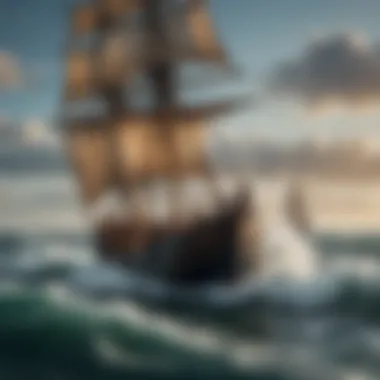
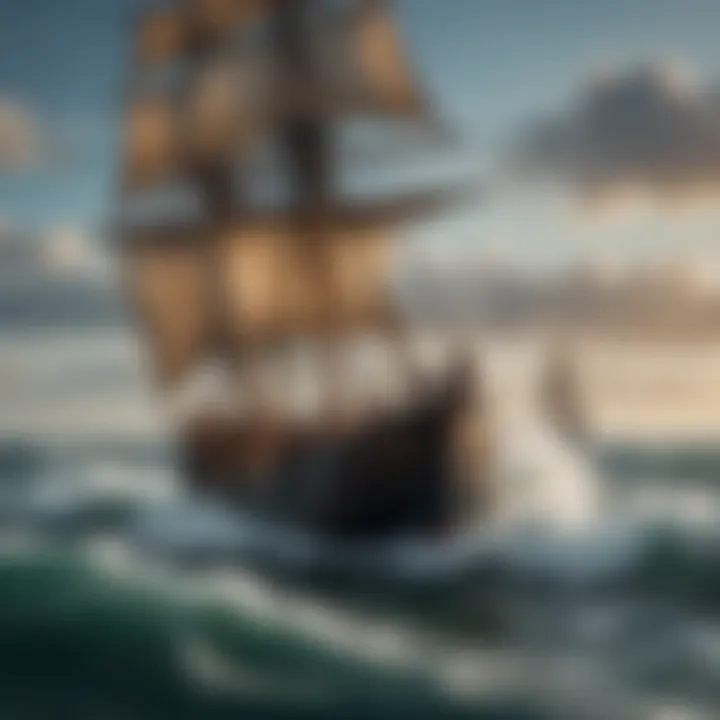
The preservation and conservation of marine art is not merely a practical necessity; it holds a mirror to the relationship between art and the natural world. The artistic representation of waves and water often draws attention not just for its aesthetic appeal but also for what it signifies about our relationship with the environment. As we develop a greater appreciation for both art and nature, understanding how to protect and maintain these artistic expressions becomes crucial.
The benefits of preserving marine art are manifold. For one, it helps maintain cultural heritage. Many artworks reflect the unique cultural narratives tied to the sea and its significance in various societies. This preservation fosters an understanding of the collective experiences and stories embedded within these artworks. Additionally, ensuring the longevity of these pieces allows future generations to engage with and learn from them, promoting a continuous dialogue about our oceans and water bodies.
Moreover, the conservation of marine art is essential for fostering environmental awareness. These artworks serve as touchstones, reminding us of the fragility of marine ecosystems. Well-preserved art can evoke deep emotional responses, prompting viewers to reflect on conservation efforts and the broader implications of human impact on nature.
Ethical Considerations in Art
When discussing the ethics surrounding the preservation of marine art, it's essential to approach the topic with sensitivity to both artistic intent and ecological impact. Artists often use their medium to raise awareness about environmental issues. Therefore, any efforts to conserve such works should consider the message conveyed by the artist.
Making sure that the techniques used for conservation are environmentally friendly can sometimes pose challenges. For example, using certain chemicals could inadvertently harm the very ecosystems that the artworks depict. Striking a balance between conservation needs and ethical responsibility must be at the forefront of discussions surrounding this topic.
- Transparency in Process: Engaging the public in conversations about preservation methods can enhance trust and support.
- Contextual Understanding: Prior knowledge of the artist's motivations can guide conservation efforts to stay true to the original message.
Role of Art in Environmental Awareness
Art has long played a pivotal role in raising awareness about environmental issues. Wave paintings, in particular, serve not just as beautiful representations of nature but as powerful reminders of its delicacy. This form of art provides a platform to communicate themes surrounding water conservation, climate change, and biodiversity loss.
The visual imagery of waves crashing or gently rolling can evoke strong feelings of beauty and urgency, compelling audiences to take action. These artworks can be used as educational tools in environmental campaigns, illustrating the consequences of pollution or climate change in a way that statistics alone may fail to achieve.
- Engagement Through Experience: Interactive exhibits or workshops can further enhance public engagement with both the art and the environmental issues it represents.
- Community Initiatives: Collaborations between artists and environmentalists can lead to projects that raise awareness while also contributing to local conservation efforts.
As the saying goes, "art speaks where words are unable to explain." The impactful role of marine art sheds light not only on the beauty of water but the urgent need to preserve it.
The Future of Wave Paintings
As we look to the horizon of artistic endeavors, the future of wave paintings is not just about colors and strokes. It's an unfolding canvas that reflects broader societal changes, technological advancement, and shifting cultural values. The ability of wave imagery to inspire awe and contemplation makes it a unique lens through which we can examine art's evolution. Artists and enthusiasts alike will benefit from understanding how this genre can evolve to reflect contemporary issues and innovations.
Emerging Trends in Art
In recent years, we have seen a significant shift in how waves are portrayed in art. Some emerging trends include:
- Sustainability in Art Practices: With environmental concerns looming large, artists are now focusing on sustainable materials and methods. Natural pigments sourced from coastal areas, for example, not only pay homage to the subject but also align art production with environmental consciousness.
- Mixed Media and Interactive Installations: The digital age beckons creators to blend traditional painting techniques with modern technology. Nowadays, many artists utilize augmented reality and interactive installations to create immersive experiences. Viewers can engage with wave paintings that seem to move and breathe, simulating the very rhythms of the ocean.
- Global Collaboration: Artists across the world are collaborating on projects that address local water issues and showcase cultural perspectives. Exhibitions that draw upon the beauty of the ocean while addressing pollution and climate change signify a merging of art with activism.
This convergence of innovation and traditional artistry presents opportunities for artists to reach broader audiences and forge meaningful connections.
Influence of Global Issues on Artistic Expression
The waves in our oceans are more than natural phenomena; they symbolize the very currents of global issues today. As we navigate through complex matters like climate change, social justice, and technological advancement, these themes greatly influence the artistic portrayal of waves.
- Climate Change Awareness: As coastal areas face rising tides and extreme weather, artists are increasingly using their work to comment on environmental crises. Paintings that depict turbulent seas or fragile shorelines call attention to the need for conservation and respect for nature's power.
- Cultural Heritage and Identity: Water holds deep significance across various cultures. Some artists use wave imagery to reflect their heritage and articulate their communities’ struggles and triumphs. Such expressions can resonate with those feeling lost or marginalized, emphasizing a shared journey.
- Mental Well-being and Reflection: In a world filled with chaos, many find solace in nature, particularly near water. Wave paintings are being used in art therapy settings to promote mental wellness, where the rhythmic patterns mimic calming sounds of the sea, fostering relaxation and meditation.
"Wave paintings are no longer just art: they are a pulse of our time, capturing the essence of ongoing narratives in our world."
In summary, the realm of wave paintings is an evolving tapestry influenced by technological progress, cultural reflection, and the pressing environmental issues of our time. As we venture into the future, the cross-pollination of art and societal challenges will undoubtedly give rise to more profound artistic expressions, ensuring waves will continue to inspire and provoke thought for generations to come.
The End and Reflections
In discussing wave painting, we find ourselves reflecting on far more than just aesthetic techniques or artistic style. The exploration into the world of waves reveals a deeper connection that transcends mere visuals. The importance of this topic lies in understanding the symbiosis between nature and human creativity, showcasing how waves, as a recurring motif, serve to encapsulate emotions, cultural narratives, and even philosophical inquiries about life's journey. By analyzing how numerous artists have portrayed this dynamic element, we highlight various approaches that not only seek to represent the physical beauty of water but also evoke the feelings tied to it—tranquility, turbulence, chaos, and harmony.
One key element is recognizing that waves can symbolize multiple narratives. For instance, they embody the idea of flowing adventure and the uncertainty present in both nature and life itself. From Hokusai’s iconic depictions to contemporary digital interpretations, these representations remind us of the fragility and transience in our existence, further encouraging a reflective state of mind.
Additionally, the benefits of engaging with wave paintings extend into environmental consciousness. As artists capture the beauty and power of the ocean, they simultaneously raise awareness regarding marine conservation and the delicate balance of ecosystems. This relationship can foster a greater appreciation and urge individuals and communities to act toward preserving our natural world.
Overall, the journey through wave painting not only illuminates artistic endeavors but also prompts us to consider our place within the vast and changing waters of life. Understanding these intricacies offers the potential for greater appreciation, not only of art but of the world around us.
Summarizing Key Insights
As we delve into the layers of wave paintings, several key insights emerge:
- Historical Significance: Waves have been a subject of fascination for centuries, influencing genres and techniques across cultures. From classical depictions that emphasize realism to abstract forms that evoke emotions, artists continue to reinterpret this theme.
- Symbolic Meanings: Water, particularly in the form of waves, symbolizes various aspects of life such as journey, change, and nature’s unpredictable nature. This motif can be perceived both as a source of inspiration and a reminder of the forces beyond our control.
- Cultural Narratives: Waves carry narratives unique to the cultures that depict them. They encapsulate stories of adventure, struggle, harmony, and connection to the Earth, allowing for rich interpretations rooted in cultural experiences.
- Emotional Responses: Art evokes emotions, and wave paintings are particularly effective at resonating with feelings of peace, longing, or exhilaration, facilitating a personal connection between the viewer and the artwork.
By capturing these insights, we recognize the profound impact that the portrayal of waves has had on the fabric of art, nature, and human experience.
Encouragement for Further Exploration
For those passionate about art and its connections to nature, continued exploration into wave paintings is not only encouraged but imperative. Here are several pathways one might consider:
- Visit Art Galleries and Museums: Experience wave paintings in person to witness the intricacies of technique and texture, allowing for a deeper appreciation of the artists’ intentions and the cultural contexts.
- Engage with Nature: Spend time by the water—be it oceans, lakes, or rivers. Observing the waves firsthand can inspire personal interpretations and creative expressions.
- Research Diverse Perspectives: Explore wave representations across different cultures. Understanding how various societies interpret waves can broaden one’s understanding of the subject in art and life.
- Experiment with Art: Trying your hand at painting water can be a therapeutic and enlightening endeavor. Breaking down the techniques discussed throughout this article could lead to personal insights on how waves signify more than they appear.
- Join Local Workshops or Online Communities: Participate in discussions about art and nature, sharing insights and experiences with fellow enthusiasts. Engaging with a community can rekindle your passion for both painting and its connection to outdoor experiences.







